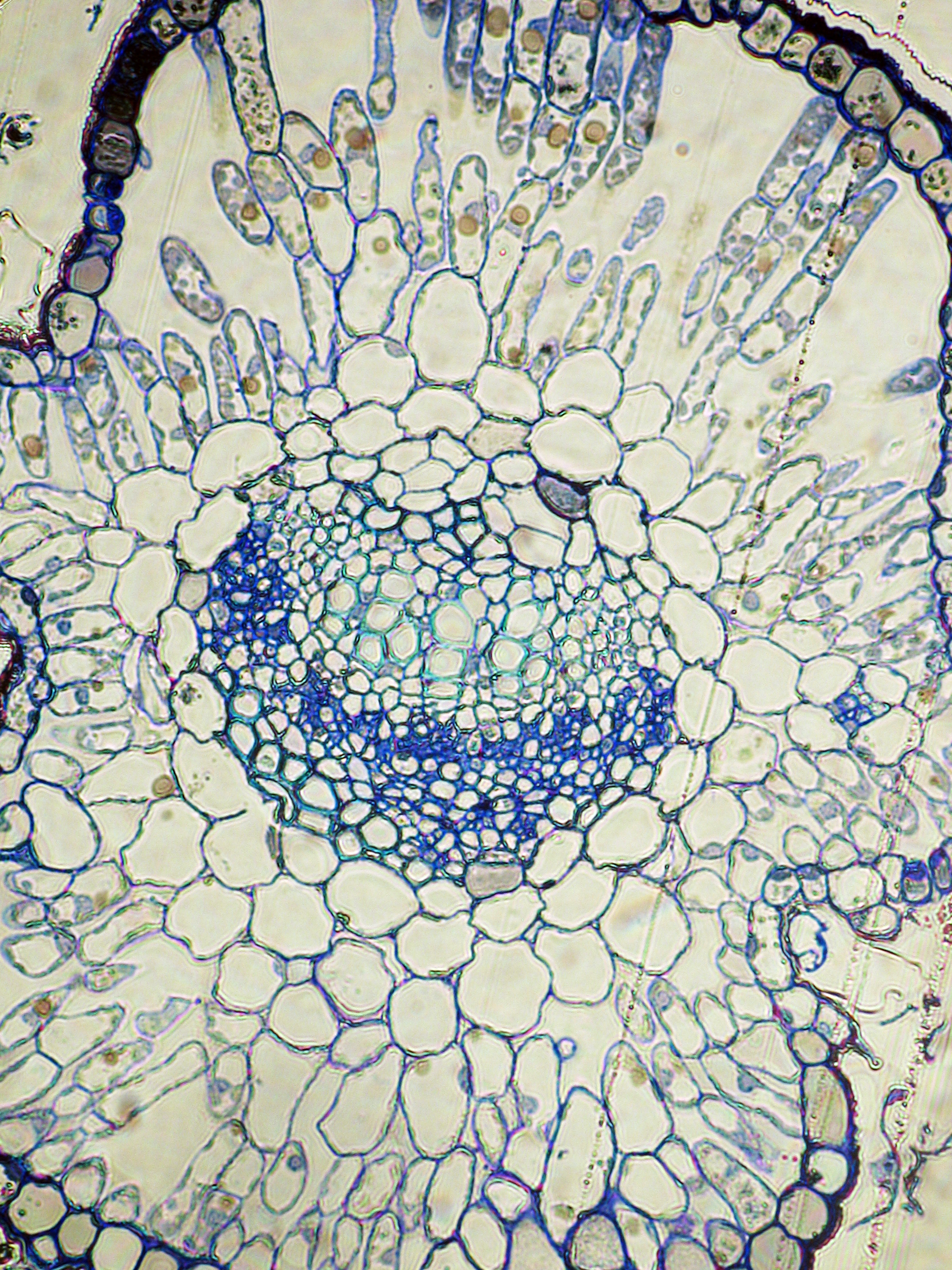Morphological and anatomical structure of leaves of Artemisia abrotanum (Asteraceae) introduced in Zhytomyr Polissya
Abstract
The upper and the lower epidermises of Artemisia abrotanum introduced in Zhytomyr Polissya are covered with cuticle. The leaf blades are amphistomatic, with oval anomocytic stomata. On adaxial and abaxial epidermal surfaces present indumentary trichomes of various types. In particular, there are located oval multi-cellular glandular trichomes, which are typical for Asteraceae. Secretory tissues of internal secretion are represented by essential oil containers. Leaf blade of A. abrotanum has isobilateral structure with collateral vascular bundles. A. abrotanum reveals certain xeromorphic traits: small and compact leaves, presence of covering trichomes, more developed palisade parenchyma in comparison with spongy one, and thick walls of epidermal cells. Investigated secretory structures and non-glandular trichomes are considered taxonomical characters and can be applied for identification of pharmaceutical raw material of A. abrotanum.
References
Boiko A.V. 2002. Eсological and biomorphological peculiarities of the genus Artemisia L. in Ukraine. Industrial Botany 2: 197–203.
Boiko G.V. 2011. The genus Artemisia L. (Asteraceae Bercht. & J. Presl) in the flora of Ukraine. Autoref. PhD. Kyiv. (In Ukrainian)
Cаrde J.-P. 1987. Electron microscopy of plant cell membranes. Methods Enzymol. 148: 599–622.
Cubukcu B., Bray D., Warhurst D., Mericli A., Ozhatay N., Sariyar G. 1990. In vitro antimalarial activity of crude extracts and compounds from Artemisia abrotanum L. Phytother. Res. 4: 203–204.
Esau K. 1980. Anatomy of seed plants. Mir, Moscow. (In Russian)
Gayer G. 1974. Electronic histological chemistry. Mir, Moscow. (In Russian)
Greuter W. 2017. Compositae (pro parte majore). In: Greuter W., von Raab-Straube E. (ed.), Compositae. Euro+Med Plantbase – the information resource for Euro-Mediterranean plant diversity. http://ww2.bgbm.org/EuroPlusMed/PTaxonDetail.asp?NameCache=Artemisia%20abrotanum&PTRefFk;=7000000
Haraim N.N. 2007. Spice-aromatic plants from the Artemisia L. genus. Proceedings of V.I. Vernadsky Tavrida National University. Ser. Biology and Chemistry 20 (4):109–114. (In Ukrainian)
Hayat M.Q., Ashraf M., Khan M.A., Yasmin G., Shaheen N., Jabeen S. 2009. Phylogenetic relationships in Artemisia spp. (Asteraceae) based on distribution of foliar trichomes. Int. J. Agric. Biol. 11: 553–558.
Hayat M.Q., Ashraf M., Jabeen S., Shaheen N., Yasmin G. 2010. Taxonomic implications of foliar epidermal characteristics with special reference to stomatal variations in the genus Artemisia (Asteraceae). Int. J. Agric. Biol. 12 (2): 221–226.
Ivashchenko I.V., Rakhmetov D.B., Ivashchenko О.А. 2014. Antimicrobial activity of ethanol extract from Artemisia abrotanum L. (Asteraceae) under conditions of introduction in Ukrainian Polissya. Proceedings of V.N. Karazin National University. Series Biology 21 (11–12): 97–105. (In Ukrainian)
Ivashchenko I.V., Rakhmetov D.B., Ivashchenko О.А. 2015. Chromatographic analysis of phenolic compounds from Artemisia austriaca Jacq., Artemisia abrotanum L. and Artemisia dracunculus L. Proc. of VI Open Congress of Phytobiologists of the Black Sea Area (Kherson – Lazurne, 19 May 2015): 93 – 94. (In Ukrainian)
Ivashchenko I.V. 2015. Fungicidal properties of essential oil plants from the Artemisia genus against Fusarium oxysporum. Biological Bulletin of Bogdan Chmelnitskiy Melitopol State Pedagogical University 5 (2): 44–53. http://dx.doi.org/10.7905/bbmspu.v5i1.974 (In Ukrainian)
Kovaliova A.M., Ochkur O.V., Kolisnyk Ya.S., Kashpur N.V. 2011. Antibacterial activity of lipophil extracts from Artemisia abrotanum L. Proc. of XVI Internat. Sci.-Pract. Conf. “Issues and ways of development of the present-day health care service”: 137–139. Kyiv, London.
Kowalski R., Wawrzykowski J., Zawiślak G. 2007. Analysis of essential oils and extracts from Artemisia abrotanum L. and Artemisia dracunculus L. Herba Pol. 53 (3): 246–254.
Minarchenko V.M. 2005. Medicinal vascular plants of Ukraine. Phytosociocentre, Kyiv. (In Ukrainian)
Noorbakhsh S.N., Ghahreman A., Attar F., Mahdigholi K. 2008. Leaf anatomy of Artemisia L. (Asteraceae) in Iran and its taxonomic implications. Iran. J. Bot. 14 (1): 54–69.
Novikoff A., Barabasz-Krasny B. 2015. Modern plant systematics. General issues. Liga-Press, Lviv. (In Ukrainian)
Ochirova K.S., Krylova E.G., Pautova I.A. 2015. The variability of the leaves structure of Artemisia absinthium (Asteraceae). Bulletin of St. Petersburg University. Ser. 3 1: 4–12. (In Russian)
Ostapko V.M., Boiko G.V., Mosyakin S.L. 2010. Vascular plants of the Southeast of Ukraine. Noulig, Donetsk. (In Russian)
Remberg P., Bjork L., Hedner T., Stemer O. 2004. Characteristic, clinical effect profile and tolerability of a nasal spray preparation of Artemisia abrotanum L. for allergic rhinitis. Phytomed. 11 (1): 36–42.
Roshchina V.D., Roshchin V.V. 1989. Secretory function of higher plants. Nauka, Moscow. (In Russian)
Sokolov P.D. (ed.) 1993. Plant resources of the USSR: Flowering plants, their chemical composition, application. The Asteraceae family (Compositae). Nauka, St. Petersburg. (In Russian)
Soropudov V.N., Nazarova N.V., Kuznetsova T.A., Kolesnikov D.A. 2013. Morphological characteristics of trichomes of Juglans species, growing under conditions of southern Mid-Russian highlands. Contemporary Issues of Science and Education 5: 1–10. (In Russian)
Soyunova J.A. 2012. Pharmacognostic study of freshly harvested raw material from certain representatives of the Artemisia L. genus and their homoeopathic matrix tinctures: Autoref. PhD 14.04.02 – Pharmaceutical chemistry, pharmacognosy. Mоscow. (In Russian)
Suresh J., Elango K., Dhanabal S.P., Paramakrishnan N., Suresh B. 2007. A comparative pharmacognostical evaluation of two Artemisia species found in Nilgiris biosphere. Anc. Sci. Life 27 (2): 7–13.
Suresh J., Fhuja J., Paramakris Hnan N., Sebastian M. 2012. Total phenolic and total flavonoids content of aerial parts of Artemisia abrotanum Linn. and A. pallens Wall. Anal. Chem. Lett. 2 (3): 186–191.
Visjulina O.D. (ed.) 1962. Flora of the Ukrainian SSR. Vol. XI. Publ. of AS of URSR, Kyiv. (In Ukrainian)
Wagner G. 1991. Secretion trichomes: More than just hairs. Plant Physiol. 96: 675–679.


This work is licensed under a Creative Commons Attribution-NonCommercial-NoDerivatives 4.0 International License.
The journal is licensed by Creative Commons under BY-NC-ND license. You are welcome and free to share (copy and redistribute the material in any medium or format) all the published materials. You may not use the material for commercial purposes. You must give appropriate credit to all published materials.
The journal allow the author(s) to hold the copyrights and to retain publishing rights without any restrictions. This is also indicated at the bottom of each article.





